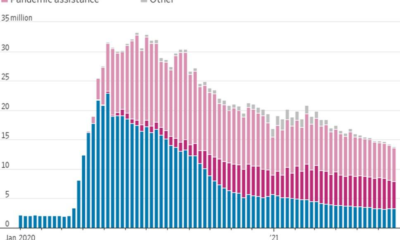Money
Adding exercise into treatment may reduce substance use, study shows

One key to fighting addiction may be exercise, according to a new study.
Researchers undertook a review of the existing literature around physical activity and its relationship to substance use, and they found that regular exercise was associated with lowered use in about 75% of the studies investigating that question, according to the analysis.
The review, published Wednesday in the journal PLOS ONE, looked at 43 studies with more than 3,000 total participants. In addition to a reduction or cessation in substance use, the studies also found improved markers of physical health and decreased depressive symptoms, the study said.
“People think that during treatment people should only do psychotherapeutic treatments … but that’s not what we’ve seen in our study,” said lead study author Florence Piché, a doctoral student and researcher at Université de Montréal in Canada. “It’s very beneficial to do physical activity in addition to the treatments.”
There are limitations to the findings. The review found that most of the studies the researchers examined had a high risk of bias, meaning more research is needed to confirm their findings, said Dr. Aaron Kandola, research fellow at Medical Research Council Unit for Lifelong Health and Ageing at University College London.
The studies were also not directly comparable enough to build a comprehensive and generalizable understanding of the relationship, Kandola said in an email. Kandola was not part of the research.
However, the findings were still significant and useful, he added.
“Substance use disorders are a major public health problem lacking low-cost, evidence-based solutions,” he said, adding that substance use disorders are worsening in many high-income countries — including the United States.
Finding more accessible solutions to this disorder is especially important because it often occurs with other mental health problems such as depression and anxiety, which disproportionately affect people with fewer socioeconomic resources and areas with higher deprivation, he said.
Physical activity may be a useful and accessible part of a treatment plan for substance use disorder, said Dr. Mark Smith, professor of psychology at Davidson College in North Carolina. Smith was not part of the research.
“I think there’s now a sufficient amount of data to indicate that various forms of physical activity and exercise are generally effective at reducing substance use in individuals seeking treatment,” he said.
What exercise does
Most people can benefit from engaging in physical activity, Kandola said.
One benefit the studies found is improvements in physical health such as cardiovascular endurance or muscle strength, Smith said. And although that may not be the primary goal of the research, he said this finding is important because it shows the physical activity is doing its job to promote physical health.
Money
Where Tech Talent Goes To Thrive

here is a worldwide shortage of digital skills. In a world increasingly reliant on technology, demand for technological skillsets is rising by as much as 50%. Meanwhile, nearly three-quarters of today’s workers don’t feel equipped to learn the digital skills needed by businesses.
The most acute shortage is in advanced skills like programming, especially for new technologies like AI and blockchain.
This demand gives skilled tech workers, entrepreneurs, and leaders the pick of where to base themselves. As cities and nations compete to attract tech talent, what makes these prized individuals choose one place over another?.
Initial Attraction
In a survey of ‘tech migrants’, Boston Consulting Group identified a mixture of short-, medium-, and long-term levers businesses and cities could use to attract talent.
The initial attraction is often brute economics: higher pay and lower taxes. That’s certainly what brings people to Dubai, says Vladimir Vrzhovski, Tech and Digital Lead at Mercer: “Dubai pays about 30% higher than most of the mature tech hubs around Europe and Asia.” It also has a lower cost of living, especially when its 0% income tax is taken into account.
Businesses operating in the city’s free zones – like the tech-focused Dubai Internet City (DIC) and Dubai International Finance Centre (DIFC) Innovation Hub – also benefit from 0% corporation tax. BCG credits the incentive with bringing big names like Amazon, Google, and Oracle to the emirate.
It is an echo of London’s rise to tech prominence, offering tax relief on tech investments via its Seed Enterprise Investment Scheme (SEIS) to funnel the city’s vast pools of finance towards digital businesses.
The presence of blue-chip names affords another major draw for tech talent: opportunities.
Money
Blood sugar drug tirzepatide also leads to substantial weight loss in diabetes patients, Eli Lilly says

There’s more evidence that the injectable drug tirzepatide helps people with diabetes lose weight as well as control their blood sugar, according to the drug’s manufacturer, Eli Lilly and Company.
In a new study, more than 900 adults with obesity and diabetes took the drug for a year and five months, and those on the highest dose lost an average of 34 pounds, or nearly 16% of their starting weight. It also helped people reduce their blood sugar, the company said in a news release. The data has not yet been peer-reviewed or published in a medical journal.
“We have not hit 15% in any other phase three trial for weight management in this type two diabetes population,” said Dr. Nadia Ahmad, an associate vice president at Eli Lilly and medical director of obesity clinical development for the company.
Ahmad said the company was pleased with these results, given how hard it is for people with type 2 diabetes to lose weight.
Tirzepatide is currently sold as Mounjaro and approved to help people with type 2 diabetes control their blood sugar.
Lilly says it will use the new study, along with results from an earlier study of weight loss in people without diabetes, to ask the US Food and Drug Administration to fast-track approval for tirzepatide purely for weight loss, which would make it a direct competitor to the blockbuster obesity drug Wegovy.
Plenty of people aren’t waiting for the FDA’s nod.
“I am aware of and I’ve heard, you know, it being sort of used off label for weight loss and individuals who do not have diabetes,” said Dr. Kimberly Gudzune, medical director of the American Board of Obesity Medicine. Gudzune was not involved in the tirzepatide study.
Gudzune points out that once a drug is FDA approved it can be prescribed for any reason a doctor sees as medically necessary.
Tirzepatide, along with several similar types of drugs taken for diabetes, went into shortage last year as success stories posted on social media fueled runaway demand for their weight loss benefits. The shortages made the medications difficult for patients with diabetes to get.
Tirzepatide works by mimicking the action of two different gut hormones. When blood sugar rises after eating, the drug stimulates the body to produce more insulin, which lowers blood sugar. It also slows down the movement of food from the stomach, making people feel fuller for longer. In clinical trials, people who took tirzepatide experienced more nausea, vomiting and diarrhea compared with those who took a placebo injection.
Semaglutide, manufactured by Novo Nordisk, has also been approved as a weight loss medication for overweight adults with at least one associated health problem since 2021. When prescribed for weight loss, it is sold under the brand name Wegovy. When prescribed for diabetes, the injection is sold under the brand name Ozempic.
High demand, coupled with manufacturing problems, threw Wegovy into shortage for much of the last year. That shortage then rippled into shortages for diabetes patients as doctors began prescribing other diabetes medications off-label for weight loss.
There has already been a lot of buzz about tirzepatide’s potential as an obesity medication. In a clinical trial published in the New England Journal of Medicine last year, people who were overweight or obese, but did not have diabetes, lost an average of 52 pounds on the highest dose of the drug, or more than 20% of their starting weight.
“In the last year has been really exciting just to have more tools in the toolbox, so to speak. And tools that, you know, we’re seeing really achieving outcomes that patients for the longest time have been hoping to achieve,” Gudzune said.
If those results hold up in the real world, that would make it the most potent of the injectable weight loss medications.
Indeed, this week Lilly aims to begin a study that will test Mounjaro against Wegovy head-to-head in 700 participants at 61 sites in the United States and Canada, according to clinicaltrials.gov. The study will conclude in February 2025.
Money
What it was like to pilot the supersonic Concorde jet

On January 21, 1976 a teenage John Tye was among crowds of onlookers clinging to a chain link fence, cheering as the first commercial British Airways Concorde flight departed from London’s Heathrow airport.
Tye was exhilarated, amazed and inspired as he saw this sleek, supersonic airplane of the future climb into the skies and make history.
Little did Tye know some 20 years later, he’d be sitting in the Concorde flight deck for the first time, pinching himself that his teenage dream was coming true.
Tye vividly recalls his first moments flying Concorde. Sure, he’d gone through extensive training, he’d practiced on the simulator – but this was the real deal. It was a feeling he could never have fully prepared for.
Tye and his fellow training pilots were in Seville, Spain. It was a beautiful Thursday evening – “the sun was just setting, you could see a big ball of fire at the end of runway,” as Tye puts it.
“We got in and started the engines, and to feel those four Rolls-Royce Olympus engines starting up and the airplane vibration for the very first time was just absolutely mind blowing,” Tye tells Travel.
Tye synchronized his watch with the training captain and the flight engineer. Then, they counted down and prepared for takeoff.
“It’s ‘three, two, one – now,’ and I pushed all four throttles fully forward in my left hand and I was just shoved back into my seat – an experience I could never describe, the acceleration as you shot off down the runway,” he says.
Then, the Concorde was in the air, building height.
“That 20 minutes was the most incredible experience in my aviation career. It was just absolutely unbelievable,” says Tye.
For nearly three decades before it retired in November 2003, Concorde aircraft sped through the skies above the Atlantic in just under three and a half hours, flying at twice the speed of sound.
Most of us can only imagine what it was like to be on board – after all, these aircraft were small, with room for just 100 passengers per flight, and ticket prices were steep.
If comparatively few people experienced what it was like to travel on Concorde, even fewer know the feeling of piloting the fastest passenger plane ever to enter commercial service.
British Airways and Air France were the only two airlines who operated the aircraft. It’s said that during the aircraft’s 27 years of service, there were more qualified American astronauts than there were British Airways Concorde pilots.
When Tye first piloted Concorde in the late 1990s, the airplane had been established for two decades. Peter Duffey was there at the very beginning, as one of the first British Airways pilots selected to trial the aircraft.
“I was involved in the development – flying with the test pilots,” Duffey tells CNN Travel. “We flew to Australia and Canada, carrying a lot of passengers.”
Duffey, who is now in his 90s, learned to fly as an Royal Air Force pilot during World War II. He later flew the de Havilland Comet, the first turbo jet engine aircraft, and one of its successors, the de Havilland Comet 4. When Concorde came calling, Duffey was an established British Airways training pilot on the Boeing 707.
“We knew Concorde was coming, and most people felt intrigued and wanted to get onto the aircraft. So I put my name down for it,” he recalls.
Duffey helped mastermind the first Concorde training scheme, and flew the aircraft until he retired in 1980.
Also there at the beginning was pilot Jock Lowe, who shares a birthday with Concorde – he turned 25 the day Concorde first took to the skies in 1969.
Lowe remembers watching the aircraft on television that day.
“I thought to myself, ‘Yeah, that’s what I’ll do. I’ll go and fly Concorde – not really realizing what was involved,’” Lowe tells CNN Travel.
Like Duffey, Lowe was one of the first British Airways pilots to test out supersonic flying at RAF Fairford, a military airbase in southwest England.
“It was quite a shock because I walked around the hangar on a foggy February morning at RAF Fairford – and I’d never even seen the aeroplane for real before,” says Lowe.”
An hour later, Lowe says he was “let loose” with the Concorde, and it felt “amazing.”
“We went up to about 63,000 feet and started to throw the aeroplane around,” he recalls. Lowe says the feeling, an analogy often echoed in Concorde circles, was “like going from a bus to a Formula One sports car.”
Lowe ended up on the first BA training course in 1976 and was still on the Concorde fleet when he retired in 2001, earning him the accolade of the longest-serving British Airways Concorde pilot.
“I flew it for longer than anyone else, by quite a margin. But, because I had lots of office jobs as well, I didn’t do as many hours as some of them,” says Lowe, who also served as BA’s flight operations director.
Richard Westray, who first piloted Concorde in 1998, echoes Lowe’s “bus to Ferrari” comparison. He says commanding a Concorde was unlike the feeling of flying any other aircraft.
“Racing down the runway for the first time, accelerating to climb into the air was one of those experiences you never forget,” Westray tells CNN Travel. “The feeling of speed during acceleration phases was just tremendous. The plane performed like no subsonic plane could perform.”
Once the Concorde was in the air, it would climb fast, “at 100 knots faster than an ordinary subsonic jet,” as former Concorde First Officer Tony Yule explains.
“You would probably climb somewhere around 2,000-4,000 feet a minute, which is really very, very fast, until initially you hit 28,000 feet,” he tells CNN Travel.
Concorde couldn’t fly supersonic over land, so after the initial ascent, it would operate subsonically – although the velocity was still “well over the speed of a 747,” as John Tye explains.
When Concorde reached the Bristol Channel, an inlet to the west of London leading to the North Atlantic, pilots would give passengers a heads up and then the aircraft would break through the sound barrier.
There was, says Tye, “no banging, no crashing, no rattling and rolling.”
Yule describes the moment the Concorde hit Mach 1 as “rather like putting a hot knife through warm butter – it slips in just like that.”
But the subsequent shock wave would create a tiny blip that would briefly impact the instruments.
“The vertical speed indicators in the flight deck would do a little dance as the supersonic shockwave passed over their external sensors,” explains Tye.
That, says Yule, is how you’d “know you’re supersonic.”
Then the pilots would make an announcement to passengers. “Ladies and gentlemen, we’ve just reached the speed of sound, Mach 1. Welcome to the world of supersonic flight.”
“And then we’re up to twice the speed of sound and nearly 60,000 feet on the ‘edge of space,’” says Tye.
Tye distinctly remembers that moment on his first-ever Concorde flight.
“I saw that curvature of the Earth, and the black sky above us, leading to infinity,” he recalls.
As for Lowe, he spent nearly three decades flying Concorde, but he says the feeling of “exhilaration” at the aircraft’s technological marvels never really faded.
“The tension, the excitement of the first flights, of the first year, it gradually reduced, obviously, but it never lost its excitement,” says Lowe. “It was always exhilarating.”
It was also, he says, always “fun.” The atmosphere on board was always electric.
“Everybody that worked with it, from the hangar floor upwards, everybody had a great deal of pride in the aeroplane and getting it right,” says Lowe.
-

 Business2 years ago
Business2 years agoHyundai Leads Industry in U.S. News & World Report 2023 Best Cars for the Money Awards
-

 Innovation2 years ago
Innovation2 years agoJay-S ventures into the urban genre with “Bailar en la Playa” his latest production
-

 Business2 years ago
Business2 years agoThree Questions Small Business Owners Should Ask In Creating A Workplace Culture – Forbes
-

 Business2 years ago
Business2 years agoA Fintech Makes It Easy For Small Businesses To Offer 401(k) Retirement Benefits – Forbes
-

 Business2 years ago
Business2 years agoBritain’s Small Businesses See Better Times Ahead But Is Their Optimism Justified? – Forbes
-

 Money2 years ago
Money2 years agoCharlie Crist leads Democratic gubernatorial field again in money chase – Florida Politics
-

 Money2 years ago
Money2 years agoTesting New Tools for Horizon Worlds Creators To Earn Money
-

 Business2 years ago
Business2 years agoSmall Business Labor Shortage – Forbes
